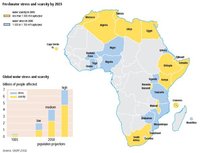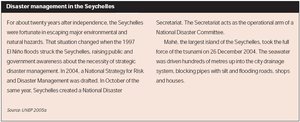Western Indian Ocean Islands and freshwater resources
Contents
- 1 Introduction Figure 1. Well-maintained marshes and rivers at the ornithological park, Bois d'Oiseaux, Mauritius. (Source: F. Silvio/TopFoto (Western Indian Ocean Islands and freshwater resources) )
- 2 Endowment and opportunities
- 3 Challenges faced in realizing opportunities for development
- 4 Strategies for improving development opportunities
- 5 Further reading
Introduction Figure 1. Well-maintained marshes and rivers at the ornithological park, Bois d'Oiseaux, Mauritius. (Source: F. Silvio/TopFoto (Western Indian Ocean Islands and freshwater resources) )
The Western Indian Ocean (WIO) islands are separated by large expanses of ocean and do not share any freshwater resources (Freshwater resources in Africa). Freshwater resources vary considerably across the islands.
Madagascar can be divided into two major basins - one draining to the west into the Mozambique Channel and the other draining to the east into the Indian Ocean. Water in Madagascar, Mauritius and the Seychelles is primarily extracted from rivers on the main inhabited islands through the construction of dams and reservoirs, while the islands of Comoros are heavily dependent on groundwater resources. The islands are subject to tropical storms or cyclones with heavy rainfall from November to May giving rise to periodic flooding. Despite the relative abundance of rainfall, the islands also experience periods of water shortage.
There are large variations in rainfall across the countries and this has implications for available freshwater resources (Freshwater resources in Africa). All the countries experience extended dry seasons with periods of heavy rain, torrential at times, which present technical problems for storage, treatment and distribution.
Endowment and opportunities
Wetlands occur throughout the island states. These wetlands are important habitats that provide breeding grounds for large numbers of waterfowl. These natural assets make the island states ideal tourist destinations.
On the Mauritius island of Agalega, 1,000 km north of Mauritius main island, the use of groundwater is declining for domestic or agricultural purposes, because of saltwater intrusion and land pollution; rainwater harvesting from pitched roofs is proving a problem because of fecal contamination from birds.
In the areas of public awareness and information, and economic measures, such as metering and charging for water use, there are opportunities to further curtail the demand for freshwater.
Challenges faced in realizing opportunities for development
Projections for the WIO islands place Mauritius in the category of water-stressed countries and Comoros in the category of water-scarce countries by 2025. Comoros is currently on the threshold, with just 1,700 m3 available per person per year. Water availability is a problem across the subregion:
 Figure 2. Freshwater stress and scarcity by 2025. (Source: UNEP 2002)
Figure 2. Freshwater stress and scarcity by 2025. (Source: UNEP 2002) - Precise figures for the Seychelles, where most water comes from rivers, are not available, but water shortages were so severe during 1998, partly as a result of the very extreme El Niño event, that the brewing and fish canning industries were forced to close;
- Mahé, which is part of the Seychelles, is under increasing threat of water shortages as a result of wilt disease that is damaging a tree species, Pterocarpus indica, important for watershed management; and
- Water supply in the Comoros on the islands of Grande Comore, Mohéli and Anjouan is threatened by the fragile equilibrium between freshwater and seawater.
In the Comoros, seawater intrusion reaches as far as 2 kilometers (km) inland due to the high water table around the coast. There are also problems of contamination of groundwater through seepage from septic tanks, substandard equipment and an insufficient number of water pumps.
The Intergovernmental Panel on Climate Change (IPCC)-projected worst-case scenario of a 1 meter sea-level rise by 2100 would result in loss of coastal land, agricultural opportunities, groundwater resources (due to salinization), biodiversity critical to community support, and in loss of livelihoods. The social impacts of a sea-level rise will cause migration and displacement of people, water-related diseases and water supply problems.
In the Seychelles, high fertilizer use means that rivers have fertilizer loads of up to 25 kilograms (kg) per day. Wells in Mauritius have high nitrate levels reaching 50 micrograms per liter, which is up to the World Health Organization-defined safety limits. Mauritius uses, on average, 57,500 tonnes of fertilizer annually, representing 600 kg per hectare, or three times the rate in western Europe. For many people in many of the WIO islands, waterborne and tropical communicable diseases are widespread, as a result of contamination of water supplies by human waste. The Comoros, for example, suffered cholera epidemics in 1975, 1998 and 2001. Two recent outbreaks were associated with poor sanitation and pollution (Water pollution) of freshwater. Poor disposal of waste, particularly containers, is also generating increased risk of malarial infections, especially in Madagascar and the Comoros.
The containers, ranging from old plastic bags to paint tins, accumulate rainwater, which is an ideal breeding ground for disease-carrying insects. Both Mauritius and the Seychelles have developed organized waste management schemes. In the Comoros, collection and disposal of waste is poorly managed.
In the Comoros, malaria is one of the principal causes of morbidity and mortality, being associated with 25 percent of hospital admissions and 10-25 percent of deaths in children under five years old. Diarrhea is a significant cause of morbidity in children in the Comoros and is associated with poor water quality.
Madagascar has health problems associated with stagnant water in irrigation canals in rice fields which promote mosquito breeding and are host to the spread of the parasites producing bilharzia. Mauritius and the Seychelles are relatively free from diseases affected by poor quality of water. Malaria has been successfully eradicated in Mauritius, although in the past it was responsible for over 2,000 deaths per year. Tourist areas throughout the sub-region have yet to introduce quality controls on water in bathing areas, although the adoption of the Blue Flag schemes of western Europe is being considered.
Strategies for improving development opportunities
The role of the private sector in financing water projects and infrastructure is increasing, although more so in Mauritius and the Seychelles than in Madagascar and Comoros. In the Seychelles, the role and importance of non-governmental organizations (NGOs) in sustainable development has increased since 1996.
In January 2005, the Mauritius Strategy was adopted, by the Small Island Developing States (SIDS) and the international community, to ensure the successful implementation of the 1994 Barbados Programme of Action (BPoA). The BPoA focuses on problems SIDS face related to climate change (Climate change and development challenges in Africa) and sea-level rise, natural and environmental disasters, freshwater resources, and capacity-building.
Selected challenges and actions related to freshwater resources in Mauritius include:
 Figure 3. Disaster management in the Seychelles. (Source: UNEP 2005a)
Figure 3. Disaster management in the Seychelles. (Source: UNEP 2005a) - Small Island Developing States continue to face water management (Governance of water resources in Africa) and water access challenges, caused in part by deficiencies in water availability, water catchment and storage, pollution of water resources, saline intrusion and leakage in the delivery system. Sustained urban water supply and sanitation systems are constrained by a lack of human, institutional and financial resources;
- Further action is required, with the necessary support from the international community, to meet the Millennium Development Goals (MDGs) and the World Summit on Sustainable Development (WSSD) 2015 targets on sustainable access to safe drinking water and sanitation, hygiene, and the production of integrated water resources management (IWRM) and water efficiency plans;
- Seek international support to build self-reliance and implement agreed priority actions, namely: IWRM, water demand management, water governance (Governance of water resources in Africa), capacity-building; and regional and inter-small island developing states water partnerships.
The next step is to outline a road map for the implementation of the strategy. Figure 3 highlights the progress made with disaster management in one of the island states, the Seychelles.
Further reading
- Government of Mauritius, 2005. Mauritius – Staking out the Future. Ministry of Environment and National Development Unit, Port Louis.
- IPCC, 2001. Climate Change 2001: Synthesis Report. A Contribution of Working Groups I, II, and III to the Third Assessment Report of the Intergovernmental Panel on Climate Change (eds.Watson, R.T. and the Core Writing Team). Cambridge University Press, Cambridge. ISBN: 0521807700
- UNEP, 2004. Indian Ocean Islands. Global International Waters Assessment, Regional Assessment 45b. University of Kalmar, Kalmar, Sweden.
- UNEP, 2005a. After the Tsunami: Rapid Environmental Assessment. United Nations Environment Programme, Nairobi.
- UNEP, 2005b. Atlantic and Indian Oceans Environment Outlook. United Nations Environment Programme, Nairobi. ISBN: 9280725254
- UNEP, 2006. Africa Environment Outlook 2
- WHO and UNICEF, 2003. The Africa Malaria Report 2003. *WHO/CDS/MAL/2003.1093.World Health Organization and the United Nations Children’s Fund.
|
|
| Disclaimer: This article is taken wholly from, or contains information that was originally published by, the United Nations Environment Programme. Topic editors and authors for the Encyclopedia of Earth may have edited its content or added new information. The use of information from the United Nations Environment Programme should not be construed as support for or endorsement by that organization for any new information added by EoE personnel, or for any editing of the original content. |